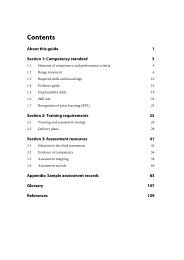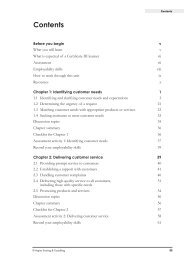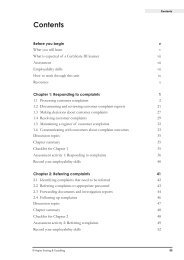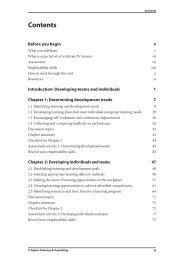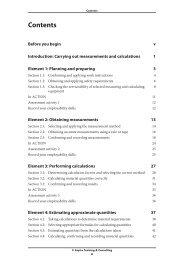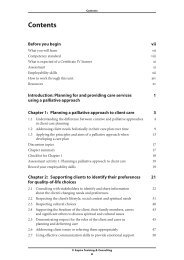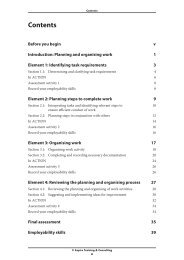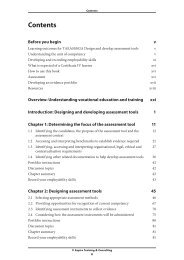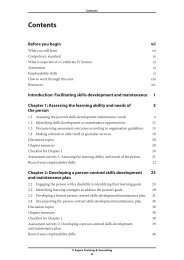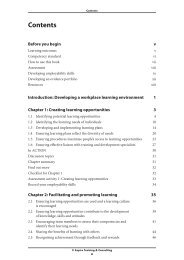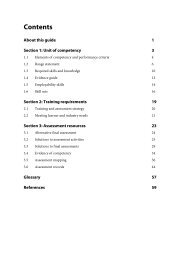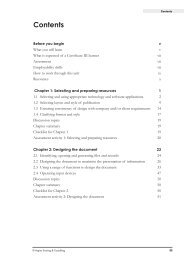BSBCMM201A Communicate in the workplace - Aspire Learning ...
BSBCMM201A Communicate in the workplace - Aspire Learning ...
BSBCMM201A Communicate in the workplace - Aspire Learning ...
You also want an ePaper? Increase the reach of your titles
YUMPU automatically turns print PDFs into web optimized ePapers that Google loves.
Contents<br />
Contents<br />
Before you beg<strong>in</strong><br />
What you will learn<br />
What is expected of a Certificate II learner<br />
Assessment <br />
Employability skills<br />
How to work through this unit<br />
Resources <br />
v<br />
v<br />
vii<br />
vii<br />
vii<br />
ix<br />
x<br />
Chapter 1: Ga<strong>the</strong>r<strong>in</strong>g, convey<strong>in</strong>g and receiv<strong>in</strong>g<br />
<strong>in</strong>formation and ideas 1<br />
1.1 Collect<strong>in</strong>g <strong>in</strong>formation to achieve work responsibilities 2<br />
1.2 Us<strong>in</strong>g methods and/or equipment to communicate ideas and <strong>in</strong>formation 7<br />
1.3 Us<strong>in</strong>g effective listen<strong>in</strong>g and speak<strong>in</strong>g skills 11<br />
1.4 Seek<strong>in</strong>g <strong>in</strong>put to develop and ref<strong>in</strong>e new ideas 22<br />
1.5 Respond<strong>in</strong>g to <strong>in</strong>structions or enquiries promptly 23<br />
Chapter summary 26<br />
Assessment checklist for Chapter 1 26<br />
Assessment activity 1: Ga<strong>the</strong>r<strong>in</strong>g, convey<strong>in</strong>g and<br />
receiv<strong>in</strong>g <strong>in</strong>formation and ideas 27<br />
Chapter 2: Complet<strong>in</strong>g <strong>workplace</strong> documentation and<br />
correspondence 29<br />
2.1 Present<strong>in</strong>g <strong>in</strong>formation <strong>in</strong> a clear and concise language<br />
to ensure mean<strong>in</strong>g is understood 30<br />
2.2 Draft<strong>in</strong>g and present<strong>in</strong>g correspondence <strong>in</strong> a timely manner 47<br />
2.3 Ensur<strong>in</strong>g organisational standards are met when present<strong>in</strong>g<br />
written <strong>in</strong>formation 47<br />
2.4 Complet<strong>in</strong>g <strong>workplace</strong> documentation <strong>in</strong> an appropriate format 50<br />
Chapter summary 65<br />
Assessment checklist for Chapter 2 66<br />
Assessment activity 2: Complet<strong>in</strong>g <strong>workplace</strong> documentation<br />
and correspondence 67<br />
© <strong>Aspire</strong> Tra<strong>in</strong><strong>in</strong>g & Consult<strong>in</strong>g iii
<strong>BSBCMM201A</strong> <strong>Communicate</strong> <strong>in</strong> <strong>the</strong> <strong>workplace</strong><br />
Chapter 3: Communicat<strong>in</strong>g <strong>in</strong> a way that responds positively<br />
to <strong>in</strong>dividual differences 71<br />
3.1 Valu<strong>in</strong>g all <strong>in</strong>dividuals and treat<strong>in</strong>g <strong>the</strong>m with respect 72<br />
3.2 Tak<strong>in</strong>g cultural differences <strong>in</strong>to consideration <strong>in</strong> all communication 75<br />
3.3 Us<strong>in</strong>g communication to develop and ma<strong>in</strong>ta<strong>in</strong> positive relationships 78<br />
3.4 Us<strong>in</strong>g basic strategies to overcome language barriers 80<br />
3.5 Ensur<strong>in</strong>g behaviour is consistent with requirements, guidel<strong>in</strong>es<br />
and protocols 82<br />
Chapter summary 85<br />
Assessment checklist for Chapter 3 86<br />
Assessment activity 3: Communicat<strong>in</strong>g <strong>in</strong> a way that responds positively<br />
to <strong>in</strong>dividual differences 87<br />
F<strong>in</strong>al Assessment: <strong>BSBCMM201A</strong> <strong>Communicate</strong> <strong>in</strong> <strong>the</strong> <strong>workplace</strong> 89<br />
Employability skills 93<br />
iv<br />
© <strong>Aspire</strong> Tra<strong>in</strong><strong>in</strong>g & Consult<strong>in</strong>g
<strong>BSBCMM201A</strong> <strong>Communicate</strong> <strong>in</strong> <strong>the</strong> <strong>workplace</strong><br />
<strong>BSBCMM201A</strong> <strong>Communicate</strong> <strong>in</strong><br />
<strong>the</strong> <strong>workplace</strong><br />
Element 1: Ga<strong>the</strong>r, convey and receive<br />
<strong>in</strong>formation and ideas<br />
1.1 Collect <strong>in</strong>formation to achieve work<br />
responsibilities from appropriate sources<br />
1.2 Use method/s and/or equipment to<br />
communicate appropriate ideas and<br />
<strong>in</strong>formation to <strong>the</strong> audience<br />
1.3 Use effective listen<strong>in</strong>g and speak<strong>in</strong>g<br />
skills <strong>in</strong> verbal communication<br />
1.4 Seek <strong>in</strong>put from <strong>in</strong>ternal and external<br />
sources to develop and ref<strong>in</strong>e new ideas<br />
and approaches<br />
1.5 Respond to <strong>in</strong>structions or enquiries<br />
promptly and <strong>in</strong> accordance with<br />
organisational requirements<br />
Element 2: Complete <strong>workplace</strong><br />
documentation and correspondence<br />
2.1 Present written <strong>in</strong>formation and ideas <strong>in</strong><br />
clear and concise language to ensure<br />
<strong>the</strong> <strong>in</strong>tended mean<strong>in</strong>g of correspondence<br />
is understood by recipient<br />
2.2 Draft and present correspondence<br />
with<strong>in</strong> designated timel<strong>in</strong>es<br />
2.3 Ensure presentation of written<br />
<strong>in</strong>formation meets organisational<br />
standards of style, format and accuracy<br />
2.4 Complete <strong>workplace</strong> forms and<br />
documentation <strong>in</strong> a clear, concise and<br />
easy to read format<br />
Element 3: <strong>Communicate</strong> <strong>in</strong> a<br />
way that responds positively to<br />
<strong>in</strong>dividual differences<br />
3.1 Value all <strong>in</strong>dividuals and treat <strong>the</strong>m with<br />
respect, courtesy and sensitivity<br />
3.2 Take <strong>in</strong>to consideration cultural<br />
differences <strong>in</strong> all verbal and<br />
non-verbal communication<br />
3.3 Use communication to develop and<br />
ma<strong>in</strong>ta<strong>in</strong> positive relationships, mutual<br />
trust and confidence<br />
3.4 Make efforts to use basic strategies to<br />
overcome language barriers<br />
3.5 Ensure that behaviour is consistent with<br />
legislative requirements, enterprise<br />
guidel<strong>in</strong>es and/or social protocols<br />
Where covered <strong>in</strong> this workbook<br />
Chapter 1: Ga<strong>the</strong>r<strong>in</strong>g, convey<strong>in</strong>g and<br />
receiv<strong>in</strong>g <strong>in</strong>formation and ideas<br />
1.1 Collect<strong>in</strong>g <strong>in</strong>formation to achieve<br />
work responsibilities<br />
1.2 Us<strong>in</strong>g methods and/or equipment to<br />
communicate ideas and <strong>in</strong>formation<br />
1.3 Us<strong>in</strong>g effective listen<strong>in</strong>g and<br />
speak<strong>in</strong>g skills<br />
1.4 Seek<strong>in</strong>g <strong>in</strong>put to develop and ref<strong>in</strong>e<br />
new ideas<br />
1.5 Respond<strong>in</strong>g to <strong>in</strong>structions or<br />
enquiries promptly<br />
Chapter 2: Complet<strong>in</strong>g <strong>workplace</strong><br />
documentation and correspondence<br />
2.1 Present<strong>in</strong>g written <strong>in</strong>formation <strong>in</strong><br />
clear and concise language to ensure<br />
mean<strong>in</strong>g is understood<br />
2.2 Draft<strong>in</strong>g and present<strong>in</strong>g correspondence<br />
<strong>in</strong> a timely manner<br />
2.3 Ensur<strong>in</strong>g organisational standards are<br />
met when present<strong>in</strong>g written <strong>in</strong>formation<br />
2.4 Complet<strong>in</strong>g <strong>workplace</strong> documentation <strong>in</strong><br />
an appropriate format<br />
Chapter 3: Communicat<strong>in</strong>g <strong>in</strong> a<br />
way that responds positively to<br />
<strong>in</strong>dividual differences<br />
3.1 Valu<strong>in</strong>g all <strong>in</strong>dividuals and treat<strong>in</strong>g <strong>the</strong>m<br />
with respect<br />
3.2 Tak<strong>in</strong>g cultural differences <strong>in</strong>to<br />
consideration <strong>in</strong> all communication<br />
3.3 Us<strong>in</strong>g communication to develop and<br />
ma<strong>in</strong>ta<strong>in</strong> positive relationships<br />
3.4 Us<strong>in</strong>g basic strategies to overcome<br />
language barriers<br />
3.5 Ensur<strong>in</strong>g behaviour is consistent with<br />
requirements, guidel<strong>in</strong>es and protocols<br />
vi<br />
© <strong>Aspire</strong> Tra<strong>in</strong><strong>in</strong>g & Consult<strong>in</strong>g
Before you beg<strong>in</strong><br />
What is expected of a Certificate II Learner<br />
This unit has been mapped to a Level 2 competency standard from <strong>the</strong> BSB07 Bus<strong>in</strong>ess<br />
Services Tra<strong>in</strong><strong>in</strong>g Package.<br />
At this level you are expected to meet <strong>the</strong> follow<strong>in</strong>g learn<strong>in</strong>g outcomes:<br />
• To demonstrate basic operational knowledge <strong>in</strong> a moderate range of areas.<br />
• To apply a def<strong>in</strong>ed range of skills.<br />
• To apply known solutions to a limited range of predictable problems.<br />
• To perform a range of tasks where choice between a limited range of options<br />
is required.<br />
• To assess and record <strong>in</strong>formation from varied sources.<br />
• To take limited responsibility for own outputs <strong>in</strong> work and learn<strong>in</strong>g.<br />
Assessment<br />
In accordance with <strong>the</strong> evidence guidel<strong>in</strong>es stated with<strong>in</strong> <strong>the</strong> BSB07 Bus<strong>in</strong>ess Services<br />
Tra<strong>in</strong><strong>in</strong>g Package, assessment of performance requirements <strong>in</strong> this unit should be<br />
undertaken <strong>in</strong> an actual <strong>workplace</strong> or simulated environment.<br />
For you to be assessed as competent <strong>in</strong> this unit, you need to demonstrate your skills<br />
and knowledge <strong>in</strong> a number of ways over a period of time. The assessment should<br />
be carried out over a sufficient period of time to allow you to demonstrate <strong>the</strong> way <strong>in</strong><br />
which you use your skills and knowledge to use effective speak<strong>in</strong>g and listen<strong>in</strong>g skills,<br />
present written <strong>in</strong>formation and ideas <strong>in</strong> a clear and concise manner and implement<br />
strategies to overcome barriers that may effect communication.<br />
Dur<strong>in</strong>g this time your tra<strong>in</strong>er may:<br />
• ask you questions about <strong>the</strong> work you have done<br />
• observe you carry<strong>in</strong>g out specific tasks<br />
• ask o<strong>the</strong>r people to comment on your work<br />
• take <strong>in</strong>to account feedback about your work<br />
• ask you to prepare a portfolio of your work<br />
• ask you to demonstrate your skills<br />
• ask you to complete assessment activities for each chapter<br />
• give you a f<strong>in</strong>al assessment to complete.<br />
Employability skills<br />
Develop<strong>in</strong>g employability skills<br />
Employers <strong>in</strong> Australia and overseas have made it very clear that <strong>the</strong> task specific<br />
knowledge and skills people develop <strong>in</strong> learn<strong>in</strong>g programs are not enough to make<br />
<strong>the</strong>m productive, valued employees. Employers today value people who fit well <strong>in</strong>to<br />
<strong>the</strong>ir <strong>workplace</strong>, use <strong>the</strong>ir <strong>in</strong>itiative to solve day-to-day problems, work productively,<br />
manage <strong>the</strong>ir time effectively and are keen to cont<strong>in</strong>ue learn<strong>in</strong>g. These types of skills<br />
are known as employability skills.<br />
© <strong>Aspire</strong> Tra<strong>in</strong><strong>in</strong>g & Consult<strong>in</strong>g vii
<strong>BSBCMM201A</strong> <strong>Communicate</strong> <strong>in</strong> <strong>the</strong> <strong>workplace</strong><br />
Faxes (facsimiles)<br />
Facsimile means ‘exact copy’. ‘Fax’ is <strong>the</strong> abbreviation of facsimile. Organisations use<br />
fax mach<strong>in</strong>es to send pr<strong>in</strong>ted <strong>in</strong>formation. Information can be transmitted from <strong>the</strong><br />
fax mach<strong>in</strong>e, or directly from your computer, if your computer is connected to <strong>the</strong><br />
fax mach<strong>in</strong>e.<br />
Faxes are usually sent if <strong>the</strong> <strong>in</strong>formation needs to be relayed quickly. They are faster than<br />
letters, and are cheaper than an overnight postal delivery. The document has less chance<br />
of be<strong>in</strong>g lost, and <strong>the</strong> receiver gets an accurate, exact copy of <strong>the</strong> <strong>in</strong>formation.<br />
There are some disadvantages. Faxes can be difficult to read, may not transmit properly<br />
and can be delayed if <strong>the</strong> transmission l<strong>in</strong>es are busy. You can only send separate,<br />
unbound pages by fax. Security can also be a problem, as anyone can pick up and read<br />
a fax as it comes off <strong>the</strong> mach<strong>in</strong>e.<br />
The ease of send<strong>in</strong>g email and scanned documents has meant that faxes are less<br />
commonly used than <strong>the</strong>y have been <strong>in</strong> <strong>the</strong> past.<br />
Word process<strong>in</strong>g<br />
Word process<strong>in</strong>g software is <strong>the</strong> most commonly used software <strong>in</strong> <strong>the</strong> world. Why<br />
Because anyone can use it to produce a professional-look<strong>in</strong>g document. This saves<br />
time and pr<strong>in</strong>t<strong>in</strong>g costs. Common word process<strong>in</strong>g software <strong>in</strong>cludes Lotus WordPro,<br />
Microsoft Word and WordPerfect.<br />
A common word process<strong>in</strong>g task is writ<strong>in</strong>g letters. Letters are used to pass on a variety<br />
of bus<strong>in</strong>ess <strong>in</strong>formation. They are <strong>the</strong> preferred method of communication when a<br />
record of <strong>the</strong> bus<strong>in</strong>ess activity is required. A well-written and well-presented letter<br />
makes a good impression on <strong>the</strong> reader.<br />
The ma<strong>in</strong> disadvantage with us<strong>in</strong>g word process<strong>in</strong>g software is that it makes it too<br />
easy to produce a document. People often send letters that are not as well-written or<br />
well-presented as <strong>the</strong>y should be. Letter writ<strong>in</strong>g is a skill that takes practice. Produc<strong>in</strong>g<br />
a letter for somebody else also takes some discipl<strong>in</strong>e. Always follow <strong>the</strong> requirements<br />
of your organisation regard<strong>in</strong>g format and style. Always check your work for errors<br />
before send<strong>in</strong>g it out.<br />
Stationery<br />
At times <strong>the</strong> most appropriate way to pass on <strong>in</strong>formation is simply to write a note.<br />
Always keep your stationery tidy and a message pad by <strong>the</strong> phone. Telephone messages<br />
and handwritten memos are still very common ways of communicat<strong>in</strong>g.<br />
The ma<strong>in</strong> disadvantage with this type of communication is your handwrit<strong>in</strong>g. Can it be<br />
read Write clearly! Some people f<strong>in</strong>d it difficult to read o<strong>the</strong>r people’s handwrit<strong>in</strong>g. If<br />
your handwrit<strong>in</strong>g is not easy to read it is better to carefully pr<strong>in</strong>t <strong>the</strong> message, perhaps<br />
us<strong>in</strong>g upper-case letter<strong>in</strong>g (capitals). Also, a hand-written message or note can easily be<br />
lost. Make sure you leave <strong>the</strong> message <strong>in</strong> a safe and obvious place.<br />
10 © <strong>Aspire</strong> Tra<strong>in</strong><strong>in</strong>g & Consult<strong>in</strong>g
Chapter 1: Ga<strong>the</strong>r<strong>in</strong>g, convey<strong>in</strong>g and receiv<strong>in</strong>g <strong>in</strong>formation and ideas<br />
Practice task 9<br />
Th<strong>in</strong>k of a hand-written message that you have received recently at work, at home or <strong>in</strong><br />
your place of study.<br />
•<br />
•<br />
•<br />
Could you read <strong>the</strong> handwrit<strong>in</strong>g<br />
Did it pass on all <strong>the</strong> <strong>in</strong>formation<br />
How might it have been improved<br />
Electronic presentations<br />
Overhead projectors, electronic whiteboards and multimedia presentations are useful<br />
ways of pass<strong>in</strong>g on <strong>in</strong>formation at a meet<strong>in</strong>g. Overhead projectors are an older<br />
technology but are still useful. Multimedia allows for more variety <strong>in</strong> presentation.<br />
Electronic whiteboards allow you to pr<strong>in</strong>t a copy of what is written on <strong>the</strong>m.<br />
The ma<strong>in</strong> disadvantage with us<strong>in</strong>g this type of equipment is <strong>the</strong> technology itself. What<br />
if <strong>the</strong> room doesn’t have enough power po<strong>in</strong>ts or a large enough screen What if <strong>the</strong><br />
multimedia presentation malfunctions To avoid any nasty surprises, make sure everyth<strong>in</strong>g<br />
is connected and <strong>in</strong> good work<strong>in</strong>g order before <strong>the</strong> presentation or meet<strong>in</strong>g beg<strong>in</strong>s.<br />
Practice task 10<br />
Th<strong>in</strong>k of any meet<strong>in</strong>gs, talks or lectures you have been to where <strong>the</strong> speaker used a<br />
whiteboard, an overhead projector, PowerPo<strong>in</strong>t or ano<strong>the</strong>r form of electronic presentation.<br />
•<br />
•<br />
•<br />
Comment on how successful you th<strong>in</strong>k <strong>the</strong> presentation was.<br />
Comment on anyth<strong>in</strong>g you th<strong>in</strong>k was not successful.<br />
How could <strong>the</strong> presentation have been improved<br />
1.3 Us<strong>in</strong>g effective listen<strong>in</strong>g and speak<strong>in</strong>g skills<br />
Us<strong>in</strong>g effective listen<strong>in</strong>g and speak<strong>in</strong>g skills<br />
To communicate successfully at work you need to be able to ask for and pass on<br />
<strong>in</strong>formation effectively and clearly. This can be done verbally or <strong>in</strong> writ<strong>in</strong>g. The next<br />
section looks at how to communicate well verbally, ei<strong>the</strong>r face to face or on <strong>the</strong><br />
telephone. Chapter 2 looks at how to communicate well <strong>in</strong> writ<strong>in</strong>g.<br />
Verbal communication is effective and fast. Two people can exchange <strong>in</strong>formation and<br />
respond to each o<strong>the</strong>r <strong>in</strong>stantly. Some common examples of verbal communication <strong>in</strong><br />
<strong>the</strong> <strong>workplace</strong> <strong>in</strong>clude:<br />
• speak<strong>in</strong>g on <strong>the</strong> telephone<br />
• us<strong>in</strong>g voicemail<br />
• pass<strong>in</strong>g messages from one person to ano<strong>the</strong>r<br />
• answer<strong>in</strong>g requests for <strong>in</strong>formation from your colleagues<br />
• receiv<strong>in</strong>g <strong>in</strong>structions from your supervisor and clarify<strong>in</strong>g what you need to do<br />
© <strong>Aspire</strong> Tra<strong>in</strong><strong>in</strong>g & Consult<strong>in</strong>g 11
<strong>BSBCMM201A</strong> <strong>Communicate</strong> <strong>in</strong> <strong>the</strong> <strong>workplace</strong><br />
•<br />
•<br />
tak<strong>in</strong>g part <strong>in</strong> <strong>in</strong>formal discussions or meet<strong>in</strong>gs<br />
answer<strong>in</strong>g enquiries from clients.<br />
Many people th<strong>in</strong>k that verbal communication is <strong>the</strong> easiest way to communicate. But is<br />
it really To be a good communicator you need to be able to speak, and listen, very well.<br />
Listen<strong>in</strong>g effectively<br />
Listen<strong>in</strong>g is very important to <strong>the</strong> communication process. It is how you receive and<br />
understand <strong>in</strong>formation and ideas. Through listen<strong>in</strong>g it is possible to learn:<br />
• what <strong>the</strong> o<strong>the</strong>r person’s needs are<br />
• what <strong>in</strong>formation <strong>the</strong> o<strong>the</strong>r person is try<strong>in</strong>g to share<br />
• what <strong>the</strong> o<strong>the</strong>r person th<strong>in</strong>ks about someth<strong>in</strong>g<br />
• whe<strong>the</strong>r <strong>the</strong> o<strong>the</strong>r person has understood what has been said.<br />
A great deal of your time is spent listen<strong>in</strong>g to o<strong>the</strong>r people. Most people will agree that<br />
good listen<strong>in</strong>g is hard work. It takes an effort and some practice, but can be achieved<br />
if you keep try<strong>in</strong>g.<br />
Follow<strong>in</strong>g are some tips that will help you be a better listener at work.<br />
Ask questions to clarify <strong>in</strong>formation<br />
If you didn’t hear someth<strong>in</strong>g properly, or don’t understand someth<strong>in</strong>g that has been<br />
said, ask questions to clarify <strong>the</strong> <strong>in</strong>formation. Most people don’t m<strong>in</strong>d as long as you<br />
are polite.<br />
This is especially important if someone is giv<strong>in</strong>g you <strong>in</strong>structions. In this case, you<br />
need to thoroughly understand what needs to be done.<br />
Make sure you listen carefully. Don’t <strong>in</strong>terrupt. Concentrate on what <strong>the</strong> o<strong>the</strong>r person<br />
is say<strong>in</strong>g. In particular, listen for <strong>the</strong> ma<strong>in</strong> steps or stages of <strong>the</strong> task or <strong>the</strong> key po<strong>in</strong>ts<br />
that you have to remember. If you th<strong>in</strong>k you might have trouble remember<strong>in</strong>g, write<br />
it down.<br />
Ask questions. Don’t let <strong>the</strong>re be any misunderstand<strong>in</strong>g. Clarify anyth<strong>in</strong>g that is not<br />
clear or that you don’t understand.<br />
Practice task 11<br />
Th<strong>in</strong>k of <strong>the</strong> last time you were given an <strong>in</strong>struction.<br />
• Did you understand all <strong>the</strong> steps or stages of <strong>the</strong> task If not, did you ask questions to<br />
help you clarify <strong>the</strong> <strong>in</strong>formation<br />
• What might have happened if you had not thoroughly understood <strong>the</strong> key po<strong>in</strong>ts<br />
12 © <strong>Aspire</strong> Tra<strong>in</strong><strong>in</strong>g & Consult<strong>in</strong>g
Chapter 1: Ga<strong>the</strong>r<strong>in</strong>g, convey<strong>in</strong>g and receiv<strong>in</strong>g <strong>in</strong>formation and ideas<br />
Ask questions to clarify needs<br />
When you listen to someone it is also a good idea to clarify (check <strong>the</strong> mean<strong>in</strong>g of)<br />
what has been said. This is particularly important when you are faced with an enquiry<br />
or somebody is ask<strong>in</strong>g you for <strong>in</strong>formation – whe<strong>the</strong>r it be a colleague, supervisor or<br />
customer. It might mean check<strong>in</strong>g <strong>the</strong> mean<strong>in</strong>g of someth<strong>in</strong>g you have just heard, or<br />
ask<strong>in</strong>g more questions to f<strong>in</strong>d out what <strong>the</strong> person really needs.<br />
Requests for <strong>in</strong>formation can be ei<strong>the</strong>r face-to-face or over <strong>the</strong> telephone. You will be<br />
able to answer some requests directly. Some you will not. Ei<strong>the</strong>r way, you must listen<br />
carefully. It is important to clarify what you have heard so that you know what type of<br />
<strong>in</strong>formation is required.<br />
If <strong>the</strong> enquiry is for rout<strong>in</strong>e <strong>in</strong>formation, try to answer promptly. If you can help your<br />
visitor or caller quickly and efficiently, <strong>the</strong>y will have a good impression of you and<br />
your organisation.<br />
The follow<strong>in</strong>g questions can be answered immediately.<br />
• What time do you close<br />
• Can you give me some <strong>in</strong>formation about your organisation<br />
• Does your organisation deal with home <strong>in</strong>surance<br />
• I heard about your organisation on <strong>the</strong> radio. Can you tell me <strong>the</strong> benefits of<br />
becom<strong>in</strong>g a member What does it cost<br />
• Could you tell me <strong>the</strong> website address of your organisation<br />
If <strong>the</strong> enquiry is not rout<strong>in</strong>e it may take a little longer to collect <strong>the</strong> <strong>in</strong>formation<br />
required, as <strong>in</strong> <strong>the</strong> next example.<br />
© <strong>Aspire</strong> Tra<strong>in</strong><strong>in</strong>g & Consult<strong>in</strong>g 13
<strong>BSBCMM201A</strong> <strong>Communicate</strong> <strong>in</strong> <strong>the</strong> <strong>workplace</strong><br />
Practice task 12<br />
Read <strong>the</strong> case study. Write down, or tell your tra<strong>in</strong>er, your answers to <strong>the</strong> questions.<br />
Case study<br />
Moana works for a travel agent. A customer came <strong>in</strong> and wanted to go on a holiday<br />
to Europe but was unsure of <strong>the</strong> details.<br />
Moana asked <strong>the</strong> customer some questions to clarify her needs, for example her<br />
budget, what she wanted to see, and whe<strong>the</strong>r she wanted flexibility or security. Then,<br />
she expla<strong>in</strong>ed <strong>the</strong> features and benefits of travell<strong>in</strong>g <strong>in</strong> a group and travell<strong>in</strong>g alone.<br />
Before Moana could help her customer, she needed to listen to her customer to f<strong>in</strong>d<br />
out her needs. Through listen<strong>in</strong>g she discovered that <strong>the</strong> customer wanted to holiday <strong>in</strong><br />
Europe but didn’t know whe<strong>the</strong>r to travel <strong>in</strong> a group or by herself. Moana asked some<br />
more questions to clarify her needs and listened to what she was told.<br />
Once she found out what her customer wanted, Moana was able to provide <strong>in</strong>formation<br />
about what was available and what would suit her customer’s needs.<br />
1. If Moana had not listened carefully to <strong>the</strong> customer, what might she have done<br />
2. What might have been <strong>the</strong> result<br />
3. Have you ever been to a shop and been served by someone who did not listen carefully<br />
to what you wanted If so, what did you do How did you feel<br />
Listen for total mean<strong>in</strong>g<br />
To be a good listener you need to use your ears and your eyes. You need to listen for<br />
total mean<strong>in</strong>g, to both <strong>the</strong> words that <strong>the</strong> person is say<strong>in</strong>g and how those words are<br />
be<strong>in</strong>g said.<br />
The non-verbal part of a message is often called body language. This <strong>in</strong>cludes facial<br />
expressions, posture and gestures. Often, people are unaware of <strong>the</strong>ir body language,<br />
but it can tell you more about how <strong>the</strong>y are feel<strong>in</strong>g than <strong>the</strong>ir words.<br />
For example:<br />
• if a shop assistant smiles at you while talk<strong>in</strong>g, it may communicate that <strong>the</strong>y are<br />
happy to help you<br />
• if <strong>the</strong> shop assistant does o<strong>the</strong>r th<strong>in</strong>gs while <strong>the</strong>y talk and does not look you <strong>in</strong> <strong>the</strong><br />
eye, you may th<strong>in</strong>k <strong>the</strong>y are not <strong>in</strong>terested <strong>in</strong> help<strong>in</strong>g you.<br />
Practice task 13<br />
•<br />
•<br />
Describe a situation when you felt <strong>the</strong> body language of <strong>the</strong> person speak<strong>in</strong>g was<br />
communicat<strong>in</strong>g someth<strong>in</strong>g different to what was be<strong>in</strong>g said.<br />
Carry out <strong>the</strong> follow<strong>in</strong>g role-plays with a group at school or with friends:<br />
–– The speaker is say<strong>in</strong>g that he is very <strong>in</strong>terested <strong>in</strong> <strong>the</strong> o<strong>the</strong>r person’s idea, but<br />
shows by his body language that he is bored.<br />
–– The speaker is say<strong>in</strong>g she is not at all upset by a remark that has been made but is<br />
show<strong>in</strong>g by her body language that she is very upset.<br />
14 © <strong>Aspire</strong> Tra<strong>in</strong><strong>in</strong>g & Consult<strong>in</strong>g
Chapter 1: Ga<strong>the</strong>r<strong>in</strong>g, convey<strong>in</strong>g and receiv<strong>in</strong>g <strong>in</strong>formation and ideas<br />
Repeat back what you have heard<br />
At work you will often have to receive and pass on messages. The important th<strong>in</strong>g to<br />
remember is ‘<strong>the</strong> message’. Did you hear it correctly Did you pass it on accurately It<br />
is always a good idea to check.<br />
When you receive a message, repeat <strong>the</strong> <strong>in</strong>formation back to <strong>the</strong> o<strong>the</strong>r person to make<br />
sure you have heard it correctly.<br />
Some examples of people receiv<strong>in</strong>g <strong>in</strong>formation at work <strong>in</strong>clude:<br />
• somebody giv<strong>in</strong>g a task; for example, ‘Kate, would you please make 23 copies of<br />
this letter’<br />
• somebody giv<strong>in</strong>g <strong>in</strong>formation; for example, ‘I am not able to keep <strong>the</strong> appo<strong>in</strong>tment’.<br />
• tak<strong>in</strong>g an <strong>in</strong>com<strong>in</strong>g telephone call; for example, ‘This is Brad Jensen from The<br />
Times, to speak with Ms Simone Debraski’.<br />
• need<strong>in</strong>g to pass on a message to someone else; for example, ‘Russell, if Mr Arendt<br />
calls, please tell him that I’ll phone after 3.00 pm’.<br />
By listen<strong>in</strong>g carefully, you should be able to pass on <strong>the</strong> <strong>in</strong>formation accurately. For<br />
example, <strong>in</strong> <strong>the</strong> situation above, if you told Simone that ‘Brett Johnson’ from ‘<strong>the</strong><br />
newspaper’ was on <strong>the</strong> phone, it could be very embarrass<strong>in</strong>g. Not only would Simone<br />
call Brad by <strong>the</strong> wrong name, she wouldn’t know which newspaper he was call<strong>in</strong>g from.<br />
Both of <strong>the</strong>se th<strong>in</strong>gs would make Brad th<strong>in</strong>k your organisation was unprofessional.<br />
Tips for receiv<strong>in</strong>g and pass<strong>in</strong>g on messages<br />
When receiv<strong>in</strong>g and pass<strong>in</strong>g on messages:<br />
• listen to understand what <strong>the</strong> o<strong>the</strong>r person means<br />
• clarify <strong>the</strong> message<br />
• record <strong>the</strong> <strong>in</strong>formation <strong>in</strong> <strong>the</strong> message accurately<br />
• relay <strong>the</strong> message accurately and as soon as possible (verbally or <strong>in</strong> writ<strong>in</strong>g).<br />
Take notes<br />
Sometimes good listen<strong>in</strong>g can only be achieved by tak<strong>in</strong>g notes. A good example of this<br />
is when you are deal<strong>in</strong>g with messages left on voicemail or an answer<strong>in</strong>g mach<strong>in</strong>e.<br />
Many organisations use answer<strong>in</strong>g mach<strong>in</strong>es/voicemail to record messages from<br />
people when no-one can answer <strong>the</strong> telephone.<br />
If <strong>the</strong>re are messages left you need to listen very carefully. You may even need to replay<br />
<strong>the</strong>m. This is because some callers do not speak clearly, or <strong>the</strong>y speak too quickly. You<br />
will have to write down <strong>the</strong>:<br />
•<br />
•<br />
•<br />
•<br />
date and time of each call<br />
name of <strong>the</strong> caller<br />
telephone number of <strong>the</strong> caller<br />
caller’s message (if one has been left).<br />
If somebody has left a very long message, simply write down <strong>the</strong> ma<strong>in</strong> po<strong>in</strong>ts.<br />
© <strong>Aspire</strong> Tra<strong>in</strong><strong>in</strong>g & Consult<strong>in</strong>g 15
<strong>BSBCMM201A</strong> <strong>Communicate</strong> <strong>in</strong> <strong>the</strong> <strong>workplace</strong><br />
Practice task 14<br />
•<br />
•<br />
Do you have an answer<strong>in</strong>g mach<strong>in</strong>e or voicemail facility at work or at home What<br />
type of notes do you take when listen<strong>in</strong>g to <strong>the</strong> messages<br />
Have you ever erased messages before tak<strong>in</strong>g down <strong>the</strong> <strong>in</strong>formation Describe what<br />
happened. What were <strong>the</strong> consequences<br />
Speak<strong>in</strong>g effectively<br />
Talk<strong>in</strong>g to somebody and communicat<strong>in</strong>g are not <strong>the</strong> same th<strong>in</strong>g. What if <strong>the</strong> person can’t<br />
hear you very well What if <strong>the</strong>y don’t understand <strong>the</strong> language For communication to<br />
take place, both people must understand <strong>the</strong> <strong>in</strong>formation <strong>in</strong> <strong>the</strong> same way.<br />
Most of <strong>the</strong> time, people don’t th<strong>in</strong>k about how <strong>the</strong> o<strong>the</strong>r person will <strong>in</strong>terpret <strong>the</strong><br />
<strong>in</strong>formation. They assume <strong>the</strong> person will understand what is meant. For example, if<br />
you say to someone, ‘Please pass <strong>the</strong> sugar’, you assume that <strong>the</strong>y know you want <strong>the</strong>m to<br />
pick up <strong>the</strong> sugar bowl and give it to you. But you are also assum<strong>in</strong>g that <strong>the</strong> person:<br />
• can hear you<br />
• speaks English<br />
• knows what sugar is.<br />
But if <strong>the</strong> person didn’t hear you, doesn’t speak English, or doesn’t know what sugar is,<br />
<strong>the</strong> communication would not be successful. In all <strong>workplace</strong> communication you should<br />
speak clearly and politely and make sure <strong>the</strong> person understands what you are say<strong>in</strong>g.<br />
Us<strong>in</strong>g appropriate language and consider<strong>in</strong>g <strong>in</strong>dividual differences are important <strong>in</strong><br />
<strong>workplace</strong> communication.<br />
Use appropriate language<br />
To communicate well with ano<strong>the</strong>r person, you need to use appropriate language. This<br />
is true of both formal and <strong>in</strong>formal <strong>workplace</strong> conversations.<br />
Th<strong>in</strong>k about how you talk to a young child. They don’t understand complicated words,<br />
so you change <strong>the</strong> way you talk and use words that you th<strong>in</strong>k <strong>the</strong> child will understand.<br />
You use appropriate language so that you can communicate with <strong>the</strong> child.<br />
It should be similar at work. Before you talk to somebody, you need to th<strong>in</strong>k about<br />
what you are go<strong>in</strong>g to say and how you are go<strong>in</strong>g to say it. Us<strong>in</strong>g appropriate language<br />
will help <strong>the</strong> o<strong>the</strong>r person better understand what you are try<strong>in</strong>g to say. This is <strong>the</strong> same<br />
whe<strong>the</strong>r you are talk<strong>in</strong>g to a colleague, a visitor to <strong>the</strong> organisation or somebody on<br />
<strong>the</strong> telephone.<br />
The next example is one of <strong>in</strong>appropriate language.<br />
16 © <strong>Aspire</strong> Tra<strong>in</strong><strong>in</strong>g & Consult<strong>in</strong>g



